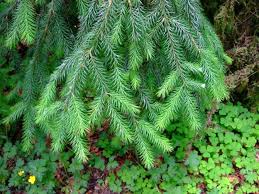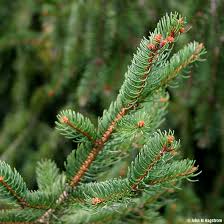Wisconsin

As you all know, we’ve been busy reviewing some of the imbiberies around the simply picturesque state of Alaska. Mountain Ranges stretching to the horizon, brilliant cerulean rivers, clear ocean water, and a postcard every which way you turn your head, Alaska has so many things that we’ve never seen before. One of those things has made itself present in various food offerings and several beer offerings and has quickly become one of our favorites. This week, we are taking a dive into spruce tips and their use in beer. You’re going to hear us talk a lot about spruce tips from our journeys in Alaska, but what they are, and how they fit into beer is going to require a bit of background explanation.
The History
First off, Spruce-tips have a long history of being used in beer throughout our country's history. Indigenous peoples of North America have been using spruce tips for hundreds of years. Because of the Vitamin C content contained in Spruce tips and other young evergreen growth, it was used as a tea, acting as a treatment for scurvy during winter months by St. Lawrence Iroquis in Canada. It was passed to French Explorers in Canada, and became widespread with the British Royal Navy and American Colonists. I’m sure the Brits loved a tea-related remedy for scurvy!
Where exactly it went from tea to beer is a little more cloudy but there is evidence that in the mid to late 1700’s Spruce Beer had emerged throughout North America with the Swedish Botanist Pehr Kalm noting French Canadians drank little else other than spruce beer. British General Jeffrey Amherst considered spruce beer important enough to the health of his troops and preventing scurvy that he recorded a recipe in 1759 and had his soldiers brewing it for themselves. During the War for Independence two Sergeants from New Hampshire, William Chamberlain and Seth Spring brewed spruce beer after the capture of Ft. Ticonderoga.
Captain James Cook, makes mention of brewing spruce beer on his 1784 voyage to the Pacific and by the end of the 18th century recipes began appearing in the new nation of America.
Amelia Simmons book American Cookery dated 1796 that includes a recipe for Spruce Beer:
“Take four ounces of hops, let them boil half an hour in one gallon of water, strain the hop water then add sixteen gallons of warm water, two gallons of molasses, eight ounces of essence of spruce, dissolved in one quart of water, put it in a clean cask, then shake it well together, add half a pint of emptins, then let it stand and work one week, if very warm weather less time will do, when it is drawn off to bottle, add one spoonful of molasses to every bottle.”
There’s much more to the history of Spruce Beer than either Hannah or I initially realized and there’s plenty more of the history of Spruce Beer and how it made it’s way into a commercial offering here. Our humble take-away was that, although we thought we stumbled on to something unique, and it is definitely somewhat unique, it turns out that this style of beer has been with us far longer than Alaska or even Wisconsin became states and there’s a storied tradition to this style. It may come initially from Canada, it’s easy to think of this as a truly North-American beer.
The Flavor
Sitka Spruce [left picture], found in the American Northwest and Canada (Alaska too), it should go without saying: is the species of Spruce that is considered most favorable for brewing beer due to its berry and citrus qualities, but other favorites are Norwegian Spruce [middle picture] for it’s brightness of flavor and Brewer’s Spruce for it’s piney qualities [right picture].
Now, you’re probably thinking
“Aren’t all spruce beers going to taste piney, regardless of species? Won’t they just taste like an IPA, you’re always describing IPA’s as ‘piney’, ‘sprucey’, etc?”
It’s both a yes and no answer. Spruce does have a pine quality to it that has been present in whatever medium we’ve tasted spruce - spruce tip jelly, beer, mead, bitters, tea - all of it has a distinct flavor that we can now easily identify as Sitka spruce. Now, I’ve I stated earlier, we often describe IPA’s as having pine qualities on the nose and when tasting. Spruce has a very smooth, slightly sweet, and airy pine quality. Think of walking through a slightly damp and cool evergreen forest and think of how the fresh air tastes. You can tell that you’re in that forest if you close your eyes and take a deep breath in. Not so strong as if you were chewing the needles, but definitely there. There’s also a certain green sweetness present, soft, slightly fuzzy, and entirely verdant on your tongue. Lastly, there’s notes of bright, cardinal-red berries with dew glistening off of them followed (usually) by a bright note of citrus but not so much that you mistake it for any particular fruit - but it’s there. If that doesn’t leave you wanting another sip, I’m not sure what will.
There is variance of course, we’ve had a few instances where that wet air feeling has become heavy and drifted dangerously close to some dank pine that we see often in IPAs. Even at its strongest though, we’ve found spruce to have a soft edge on the palate and that red fruit brightness that sets it apart and even plays brilliantly well with some hop varietals. It’s a strong enough flavor to stand out in a 14.7% stout next to another Alaskan flavor, birch syrup, enough to make itself known in an every day lager, and a brilliant flavor to add to an IPA.
We’ve quickly fallen in love with so much that Alaska has to offer in terms of stunning scenery, incredible wildlife and unbelievable adventures. To history, Spruce Beer is uniquely North American, and to use, spruce beer will always be associated with Alaska and both are something that we’re always going to want to go back to.
Until next time, keep on Crusin’, don’t stop boozin’.
Sources:












Comments